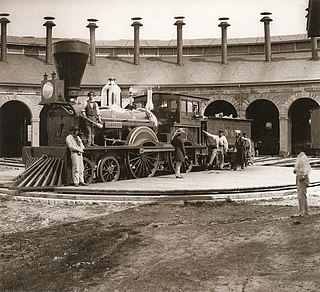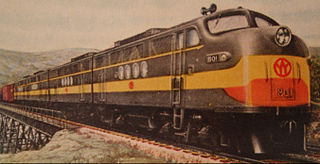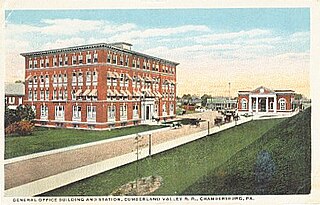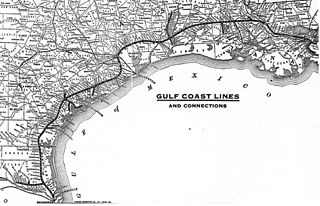
Edmeston is a town located in Otsego County, New York, United States. As of the 2010 census, the town had a total population of 1,826.
The Erie Railroad was a railroad that operated in the Northeastern United States, originally connecting Pavonia Terminal in Jersey City, New Jersey, with Lake Erie at Dunkirk, New York. The railroad expanded west to Chicago following its 1865 merger with the former Atlantic and Great Western Railroad, also known as the New York, Pennsylvania and Ohio Railroad.

The Delaware, Lackawanna and Western Railroad, also known as the DL&W or Lackawanna Railroad, was a U.S. Class 1 railroad that connected Buffalo, New York, and Hoboken, New Jersey, and by ferry with New York City, a distance of 395 miles (636 km). The railroad was incorporated in Pennsylvania in 1853, and created primarily to provide a means of transport of anthracite coal from the Coal Region in Northeast Pennsylvania to large coal markets in New York City. The railroad gradually expanded both east and west, and eventually linked Buffalo with New York City.

The New York, Susquehanna and Western Railway, also sometimes referred to as New York, Susquehanna and Western Railroad, Susie-Q or the Susquehanna, is a Class II American freight railway operating over 400 miles (645 km) of track in three Northeastern states, New Jersey, New York, and Pennsylvania.
The Lehigh Valley Railroad was a railroad in the Northeastern United States built predominantly to haul anthracite coal from the Coal Region in Northeastern Pennsylvania to major consumer markets in Philadelphia, New York City, and elsewhere.

The Delaware and Hudson Railway (D&H) is a railroad that operates in the Northeastern United States. In 1991, after more than 150 years as an independent railroad, the D&H was purchased by the Canadian Pacific Railway (CP). CP, which would itself become part of Canadian Pacific Kansas City in 2023, operated D&H under its subsidiary Soo Line Corporation, which also operates Soo Line Railroad.

The Great Western Railway was a railway that operated in Canada West, today's province of Ontario, Canada. It was the first railway chartered in the province, receiving its original charter as the London and Gore Railroad on March 6, 1834, before receiving its final name when it was rechartered in 1845.

The Livonia, Avon and Lakeville Railroad is a short line railroad that operates in Livingston County and Monroe County in New York, United States. The railroad interchanges with CSX at Genesee Junction in Chili, New York, the Rochester and Southern Railroad (RSR) at Genesee Junction and the RSR's Brooks Avenue Yard in Gates, New York, and with the Rochester & Genesee Valley Railroad Museum at Industry, New York. Their primary freight consists of food products: grains and corn syrup. In 1997, the Livonia, Avon and Lakeville Railroad was selected as Short Line Railroad of the Year by industry trade journal Railway Age. The LAL is also the parent company for the Bath and Hammondsport Railroad, the Western New York and Pennsylvania Railroad and the Ontario Midland Railroad.

The Lehigh and Hudson River Railway (L&HR) was the smallest of the six railroads that were merged into Conrail in 1976. It was a bridge line running northeast–southwest across northwestern New Jersey, connecting the line to the Poughkeepsie Bridge at Maybrook, New York with Easton, Pennsylvania, where it interchanged with various other companies.

The Middletown and New Jersey Railroad is one of two railroads in the city of Middletown, New York; the other being its interchange partner, Norfolk Southern Railway. The MNJ consists of 43 miles (69 km) of track in southeastern New York serving Orange County and the Hudson Valley. The railroad also operates and has trackage rights on three additional branch lines totalling 40 miles (64 km) leased from Norfolk Southern in Orange County. It was known as the Middletown and New Jersey Railway until 2009, when East Penn Railroad parent Regional Rail, LLC bought the line through a new subsidiary. In 2015, Regional Rail was in turn acquired by Levine Leichtman Capital Partners ("LLCP").

The New York, Ontario and Western Railway, commonly known as the O&W or NYO&W, was a regional railroad founded in 1868. The last train ran from Norwich, New York to Middletown, New York in 1957, after which it was ordered liquidated by a U.S. bankruptcy judge. It was the first Class I U.S. railroad to be abandoned in its entirety.

The Finger Lakes Railway is a Class III railroad in the Finger Lakes region of New York. The company began operations on July 23, 1995, and operates in Onondaga, Cayuga, Seneca, Ontario, Schuyler and Yates counties. The FGLK operates 18 diesel locomotives on 167 miles (269 km) of ex-Conrail trackage, formerly owned by the New York Central Railroad, the Pennsylvania Railroad and the Lehigh Valley Railroad. Between 2001 and 2013, the railroad operated a heritage railroad known as the Finger Lakes Scenic Railway which offered passenger train excursions.

The Willamette Valley Railway is a short-line railroad that operates in the Willamette Valley of Oregon. It leased a line from Woodburn to Stayton from the Southern Pacific Transportation Company in February 1993, as well as a branch from Geer west to Salem, and purchased the property in 1996. The company also leased a line between Albany and Mill City in 1993, but transferred the lease to the Albany and Eastern Railroad in October 2000.
B&H Rail Corporation, formerly the Bath & Hammondsport Railroad, is a Class III shortline railroad. Initially the line served the communities of Bath, New York and Hammondsport, New York. In Bath, the railroad connected with the Erie Railroad and the Delaware, Lackawanna and Western Railroad. In 1996, the railroad was leased by the Livonia, Avon and Lakeville Railroad.

The Cooperstown and Charlotte Valley Railroad Company is a heritage railroad in New York, operated by the Leatherstocking Chapter of the National Railway Historical Society (NRHS) since 1996.

The Cumberland Valley Railroad was an early railroad in Pennsylvania, United States, originally chartered in 1831 to connect with Pennsylvania's Main Line of Public Works. Freight and passenger service in the Cumberland Valley in south central Pennsylvania from near Harrisburg to Chambersburg began in 1837, with service later extended to Hagerstown, Maryland, and then extending into the Shenandoah Valley to Winchester, Virginia. It employed up to 1,800 workers.

Chartered on June 6, 1903, the St. Louis, Brownsville & Mexico Railway was a 200-mile (321 km) U.S. railroad that operated from Brownsville, Texas, to Gulf Coast Junction in Houston, Texas. It served numerous towns and cities along its routes and operated a rail bridge between Brownsville and Matamoros, Tamaulipas, in junction with the Mexican government. The Brownie connected the citizens of Brownsville to nearby Corpus Christi for the first time on land rather than using water transportation.
The Elmira, Cortland and Northern Railroad was a railroad in the state of New York, in the United States. Its main line ran from Elmira, New York, to Camden, New York. It was formed in 1884 from the consolidation of other railroads and merged into the Lehigh Valley Railroad in 1905. Under the Lehigh Valley, it was known as the Elmira and Cortland Branch. Almost all of its former line has since been abandoned.

Canadian Pacific 1286 is a preserved G5d class 4-6-2 "Pacific" type steam locomotive built in 1948 by the Canadian Locomotive Company. It was sold to George Hart, who used it to pull excursion trains in the 1960s. It was eventually sold again to Jack Showalter, who operated it on his Allegany Central Railroad from the early 1970s to the late 1990s. As of 2023, No. 1286 is stored under private ownership at the Prairie Dog Central Railway.















